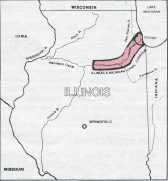 |
Home | Search | Browse | About IPO | Staff | Links |
 |
Home | Search | Browse | About IPO | Staff | Links |
|
Washington  By ROBERT MACKAY The Illinois and Michigan Canal THREE members of the Illinois congressional delegation have introduced legislation that would establish the Illinois and Michigan Canal National Heritage Corridor, a 90-mile recreational trail along the Des Plaines River Valley from Chicago to La Salle. The idea is not new. Rep. Tom Corcoran (R., Ottawa) introduced legislation in 1977 to make it a national scenic trail, in 1978 to study the possibility of making it a national historic park, and in 1979 to make it either a scenic trail or a historic park. "It's kind of been a boyhood dream for him," said Corcoran aide Scott McMurray. What makes this year different is that omnibus parks bills tend to get passed by Congress during election years, and Corcoran and the sponsors in the Senate — Charles Percy and Alan Dixon — hope to attach their legislation to just such a bill. Also in their favor is the general mood in Congress of getting the federal government off people's backs. Under the legislation, no land or property would be acquired by the federal government, and no federal environmental standards would be altered. The trail would be established through the support of the state government, local communities and private organizations. Interior Secretary James Watt called the concept "daring and precedent-setting." Basically, the legislation would establish a 15-member commission, comprised of officials from government, business, industry, and conservation and preservation groups, which would market and promote the resources of the corridor and help carry out the recommendations of a National Park Service report, which was released in December. That report provides a history of the I&M Canal and its surrounding area that few Illinoisans are probably aware of, including those who live in the corridor. Abraham Lincoln, as a state legislator, played a major role in the establishment of the I&M Canal. He convinced federal authorities that a canal connecting the Great Lakes and Mississippi River systems would be in the best interests of the federal government. 
As originally built in 1848, the canal was 36 feet wide at the bottom, 60 feet wide at water level, had a six-foot maximum depth, a 15-foot towpath, and a 90-foot reserve along both sides. It is credited with making Chicago the most important inland port of North America. The canal was active for two decades, before railroads diverted most traffic. In 1900, the Chicago Sanitary and Ship Canal replaced the I&M between Chicago and Lockport, and the main riverway was made navigable from Joliet to La Salle. The I&M was completely abandoned for navigation in 1933. During the Depression, the Civilian Conservation Corps renovated the towpath and built picnic areas, shelters and trails. Much of the I&M remains intact, including 14 of the 15 original locks, three locktender houses, two 19th century bridges, one mule barn and tavern, and three grain warehouses, in addition, the report said a majority of the towpath is suitable for trl development. A continuous trail is place from Channahon to Seneca and from Utica to La Salle, and few obstructions remain from Joliet to La Salle. There are more than 200 historical structures centered in 17 canal town the report said, and numerous geological and archeological sites. cited, among others, Isle a la Cachi where French explorers on the Dm Plaines River "cached" their furs until they had enough to return to Montreal, and the Rutherford tavern and mule barn near Dresden. The report listed several goals, including stabilizing some structures of the I&M and renovating others, providing for a continuous recreational trail from Summit to La Salle that com nects various points of interest, amtl enhancing public awareness of and appreciation for geology and for historic and prehistoric archeology. Essentially, if the corridor legislation were approved, the 15-member commission would begin by putting up signs at points of interest, printing J maps and seeking publicity. The Illnois Bell Telephone Co. conducted a study that found if existing community resources in the corridor were effectively marketed, some 700 new jobs would be created in the motel-restaurant industry in the surrounding communities. "This Heritage Corridor is an exciting new concept in park developments," Corcoran said in introducing the bill. "It reflects the new federalism philosophy supported by President Reagan. . . ." The estimated price for the park's first three years of operation is $1.5 million. The federal government would contribute only two Interior Department staff members and some technical assistance. And with Watt's support for the Corcoran-Percy-Dixon legislation, it would appear the park might just make it through Congress this time around. □ 42/May 1982/Illinois Issues |